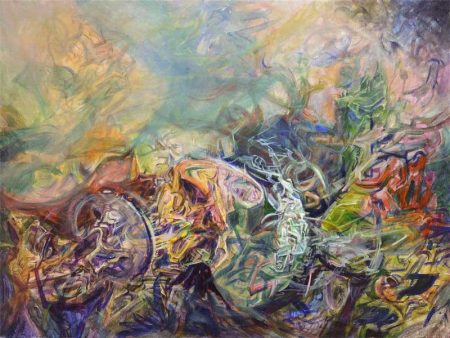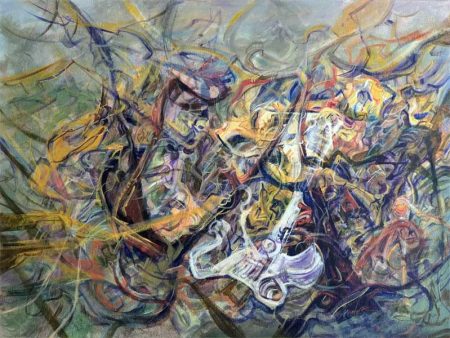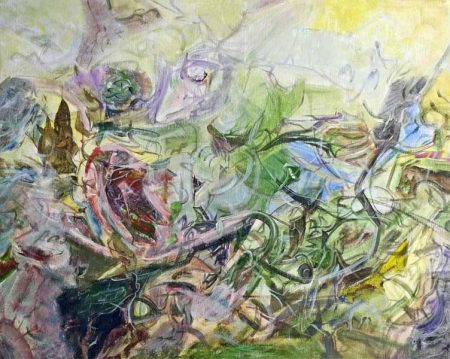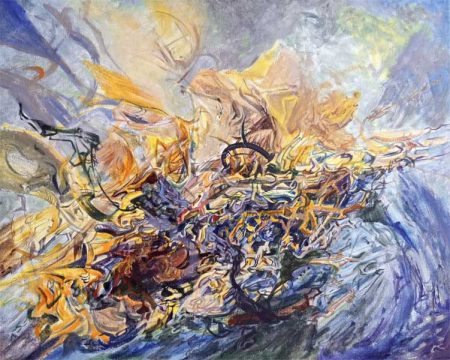One of this summer’s most impressive shows, paintings by Ivan Ivanov, was on display at the Eva Ferris Gallery at Thomas More College. Ivanov tackles big, heroic themes in his works, which are abstract, reminding us in many ways of American Abstract Expressionism, but his themes are very much his own and his painterly style is different, too, from most of the Abstract Expressionists’. Ivanov combines different styles of abstraction, as well, in his complex works, ranging from the gestural to the more geometric, to the curvilinear to the colorful: these differing types of abstraction serves his purposes well. And color’s very much key to his work–that he has in common with Jackson Pollock, and movement is critical to all of his paintings. Swirling shapes and forms of color dominate his compositions, although the viewer will also pick up curvilinear aspects that seem almost like chains, linking the various components in these works together formally. The artist isn’t shy about his colors; it’s common to see purples and greens and reds and ochres swirling through the works. Ivanov’s color reminds me of those from The Venetian Renaissance, which makes sense since the paintings deal with birth/death/rebirth (the word Renaissance means “rebirth”).
In the current era of postmodern relativism and frequent examinations of cultural production and the frequent critiques of capitalism we see these days, Ivanov’s work is unusual—and refreshing—as he tackles timeless, universalist themes. Like the Hindu goddesses Kali and Durga, Ivanov’s paintings are worlds of creation and destruction; each painting works that dialectic admirably. If we try to think of the gasses which are supposed to be the origins of our (and many others, according to astrophysicists) universe, in the process of creating form and life, we’d do well to examine Ivanov’s own attempts at explicating such. Each painting is a universe unto itself; each is an allover painting, as in Abstract Expressionism, so that the only boundaries of his world are the edges of the paintings (the eye wants to keep going beyond these boundaries, which is quite a feat on Ivanov’s part). There’s frequently a sense of the skies/ heavens above; Ivanov frequently leaves unmediated space with swirling colors to indicate the openendedness of creation, the idea of infinite creation (and, of course, affirms his own acts of creation and the implication of their infinite possibilites). One also senses the oceans below, in the lower part of the canvases, unless it’s just our own need to structure his universes according to our own sense of reason. Ivanov, of course, could turn his paintings around and we’d still sense the swirling, circular senses of creation/destruction. He’s dealing with structuring some order out of complete chaos, while suggesting that said chaos may well be of our own making; in this sense, his paintings are also radical environmental statements: it’s we who are ruining creation, the universe, our earth, the paintings propose.
And so figures and faces push and pull forward and backwards, in a partial homage to Hans Hoffman, whose lessons run through the surfaces of Ivanov’s paintings. Body parts, too, often simulating reproductive parts, also appear and disappear before us, as if they’re, too, lost in the gasses of creation, or lost to our own destructive tendencies. Sometimes these faces look demonic; at other times, almost lost in hell. There’s a definite religious component to Ivanov’s work, which is refreshing to see in these paintings, and rare in our post-religious, determinedly materialistic culture. One painting even shows us a version of God’s hand as in Michelangelo’s Sistine Ceiling, imitating the very act of creation. But destruction’s just as possible in Ivanov’s worlds. He’s proposing that we humans are just as capable of creating as of destroying; that the yin and yang of each is within each of us. Ivanov’s paintings of creation also show both the possibility of beauty and that of post-apocolyptic horror: the heaven(s) and hell are both implied and given narrative structure in his work. As he structures the paintings with curvilinear elements, we’re aware of how easily those could be broken–and how admirable to posit this in paintings, which are, of course, the work of humans, too.
The viewer will need to determine whether the paintings are hopeful or apocalyptic or both. Ivanov’s color alone proposes hope, I think, but as he asks these huge questions about creation and destruction, he gives us visual aids and clues into the worlds he has created and proposes. In Ivanov’s paintings, hope wins out because he’s chosen to paint these greatest of acts, but they also serve as cautionary warnings to what we can so easily lose by our own carelessness. Ivanov’s paintings, which are not terribly large and thus that much more impressive as he compresses so much compressed energy and force into them, are important and impressive; viewing them was a real treat, and, although the show is now over, Ivanov does live in this region and I’m certain they will be shown again. Whether we choose order or chaos is up to us, but Ivanov’s paintings are guideposts suggesting the possibility of both. The haunting beauty in them is seductive, too, and reminds us to look beyond his own beautiful surfaces to those large metaphysical issues redolent in Ivanov’s amazing paintings.
–Daniel Brown




